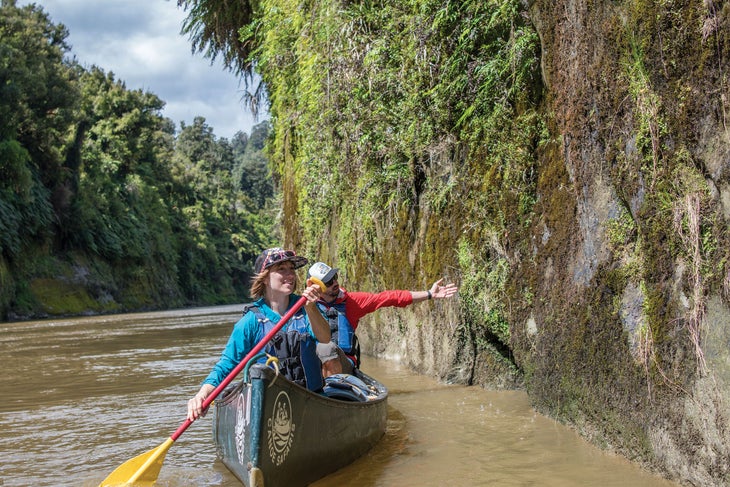Heading out the door? Read this article on the new Outside+ app available now on iOS devices for members! Download the app.
The bush around the Whanganui River is a color study in green. The mosses that begin at waterline give way to palm-like mamaku ferns that look like frozen fireworks, and then rimu trees that drip with long strands of viridian needles. The greenery clings to sheer walls, like a slot canyon crossbred with a rainforest. It’s dense enough to feel as if the Whanganui has ensconced itself in a secret world.
We’re not the only ones to think so. According to Maori legend, the first person to navigate the river was the 14th-century explorer Tamatea-Pokai-Whenua, who crossed the sea from Polynesia before paddling his canoe upstream. If Tamatea’s ocean voyage left him humbled, the legends certainly don’t record it: Upon reaching the mouth of the Whanganui on the western shore of the North Island, the first thing he did was climb the highest cliff he could find and leave a mark of ochre-red paint at the top, just to prove he was there. In a dreamscape like this one, it’s important to ground yourself in reality.
As my group paddles downstream on a 55-mile, three-day section from Whakahoro to Pipiriki, our own reality check floats just over the gunwales. Fist-size chunks of pumice bob along the water, reminders that this river’s origin is a volcano named Tongariro.

In total, the river cuts 180 miles across the North Island and occupies a unique place in the country’s lore and landscape. The Maori consider it an ancestor and a taonga—a cultural treasure—and in 2017, the government of New Zealand made it the first river to be granted personhood, with all the attendant rights and protections. Ninety of its miles are also the only riverine member of the country’s Great Walks, adventures considered to be the best.
Our guide, Phil, has been paddling the river long enough to tease out its secrets. After our first night’s extravagant ice cream dessert at a terraced campsite called John Coull Hut, he swings us around the cook shelter to an overhang filled with glow worms, shimmering in faint points of blue light. Around a bend in the river on our second day, we follow him through a boat-wide break in the gorge. There, he tells us that we’re standing on an old battleground: A group of Maori warriors lured their enemies into this canyon, then rained boulders down on them from above. We camp that night in the mowed fields below the Tieke Kainga, a Maori marae and ceremonial space, after receiving a traditional welcome from the hosts.
That evening marks the return of the rains, hammering our tents, swelling the class 2 rapids, and muddying the waters that will carry us to the takeout at Pipiriki. It’s as if the living river stood up to see us off, away from this magical, hidden place.
Senior Digital Editor Adam Roy and his partner dubbed their canoe The Kraken.
Do It
Getting there From Whanganui, drive to Whakahoro for the put-in. Route Whakahoro to Pipiriki. Spend nights at the John Coull Hut and Tieke Kainga. Reservations are required for huts between October and April Guide Canoe Safaris ($527/person for guided trips or rent for $121/person) Season October to April
